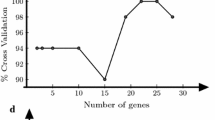Abstract
Gene expression data are expected to be a significant aid in the development of efficient cancer diagnosis and classification platforms. However, gene expression data are high-dimensional and the number of samples is small in comparison to the dimensions of the data. Furthermore, the data are inherently noisy. Therefore, in order to improve the accuracy of the classifiers, we would be better off reducing the dimensionality of the data. As a method of dimensionality reduction, there are two previous proposals: feature selection and dimensionality reduction. Feature selection is a feedback method which incorporate the classifier algorithm in the future selection process. Dimensionality reduction refers to algorithms and techniques which create new attributes as combinations of the original attributes in order to reduce the dimensionality of a data set. In this article, we compared the feature selection methods and the dimensionality reduction methods, and verified the effectiveness of both types. For the feature selection methods we used one previously known method and three proposed methods, and for the dimensionality reduction methods we used one previously known method and one proposed method. From an experiment using a benchmark data set, we confirmed the effectiveness of our proposed method with each type of dimensional reduction method.
Similar content being viewed by others
References
Mohamad MS, Deris S (2005) A hybrid of genetic algorithm and support vector machine for features selection and classification of gene expression microassay. Int J Comput Intel Appl 5(1):91–107
Tenenbaum JB, de Silva V, Langford JC (2000) A global geometric framework for nonlinear dimensionality reduction. Science 290:2319–2323
Aoki K, Kuroyanagi S, Kuguler M, et al (2005) Feature selection using a confidence margin for SVM. IEICE Trans D 12:2291–2300
Alon U, Barkai N, Notterman DA, et al (1999) Broad patterns of gene expression revealed by clustering analysis of tumor and normal colon tissues probed by oligonucleotide arrays. Proc Natl Acad Sci USA 96:6745–6750
Golub TR, Slnim DK, Tamayo P, et al (1999) Molecular classification of cancer: class discovery and class prediction by gene expression monitoring. Science 286:531–537
Author information
Authors and Affiliations
Corresponding author
Additional information
This work was presented in part at the 14th International Symposium on Artificial Life and Robotics, Oita, Japan, February 5–7, 2009.
About this article
Cite this article
Yoshioka, M., Shimoda, N. & Omatu, S. An analysis of expression data using a support vector machine and dimensional reduction methods. Artif Life Robotics 14, 80–84 (2009). https://doi.org/10.1007/s10015-009-0633-x
Received:
Accepted:
Published:
Issue Date:
DOI: https://doi.org/10.1007/s10015-009-0633-x




